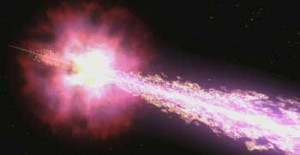
Put on your Spock ears, star gazers. An explosion in what may be one of the oldest galaxies in the universe is making headlines today.
Back in 2009, NASA's Swift Satellite captured a gamma-ray burst an estimated 13.14 billion light years away. That's much farther than any previously known galaxy, quasar, or other celestial object.
The burst, affectionately called GRB 090429B, was discovered by a team of international scientists led by Antonino Cucchiara, a graduate student at the University of Pennsylvania at the time, and now working on his doctorate at UC Berkeley.
Three years later, Cucchiara's team has finally published their findings in the Astrophysical Journal [pdf].
Cucchiara discovered the burst early in the morning of April 29, 2009. It lasted less than 10 seconds. The burst is now in competition to be named the furthest object in the universe. The other bursts up for consideration were discovered more recently -- one in 2010 by a group of observers at Observatoire de Paris (at 13.07 billion light years away), and the other in 2011 by a team at U.C. Santa Cruz (between 13.11 to 13.28 billion light years away). Those scientists are still studying the distance of those bursts, so for now, Cucchiara's gamma-ray burst at an estimated 13.14 billion light years away is considered the farthest object in the universe.